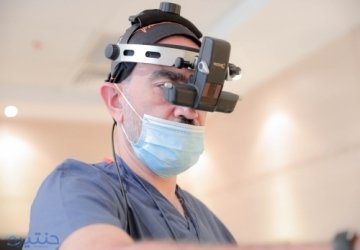Squint
is a visual disorder that affects one or both eyes, and this condition occurs when the external muscles of the eye are inconsistent in movement or if there is a much weaker eye than the other eye.
Therefore, the squint is a condition resulting from the lack of focus of light correctly on the retina due to the inconsistency of the two images of the eye that reached the brain and the part responsible for vision, and this makes vision blurry and blurred, or it may lead to a complete loss of vision in the weak eye.
Symptoms of squint
Dr. Muhammad Huntereh – Honorary Assistant Professor – Ophthalmology Department – Umm Al-Qura University – Saudi Arabia explained
It is possible to notice some symptoms on the affected person, such as:
The difference in the direction of each eye, as people with eye deviation find them when they look at a certain point, so one of the eyes looks straight and the other is looking at the other. This deviation that affects the eye may be continuous or intermittent at intervals and often affects children.
Dr. Hantira explained:
That there are some signs and symptoms that indicate squint and these symptoms include the following:
The victim suffers from blurred vision.
Constant feeling of eye fatigue and discomfort in the eyes.
Frequent headaches.
Suffering from some problems with night vision.
Among the most prominent signs: around the eye.
Causes of squint
There are no specific causes for eye deviation until now, but we can say that there are 6 external muscles of the eye that control its movement in all directions, and any defect affecting one of these muscles results in a deviation of vision.
Dr. Hanatera noted:
Squint may occur due to any of these factors:
• Some genetic factors that cause squint, such as that the mother or father has aberrant eyesight, so there is a high possibility that the child will develop eye deviation.
• squint is a condition that may be related to long-sightedness or short-sightedness, which are two of the most common and common vision problems affecting the eye.
• squint affects children with Down syndrome.
• Cases of hydrocephalus as well as cases of paralysis or brain tumors.
• Undergoing eye surgeries may cause strabismus or eye deviation, such as surgery to remove cataracts from the eye or expose the eye to severe trauma.
• The incidence of eye deviation increases during puberty.
Diagnosing squint
The patient needs to visit Dr. Hantereh in order to perform a comprehensive examination on the eye when feeling any of the previously mentioned symptoms. For the eye affected by deviation, including the following:
• Corneal reflection examination to detect eye deviation.
• Conducting a visual acuity test to determine the possibility of reading from a distance.
• Conducting tests that measure eye movement and the extent of deviation.
• Examination of the retina.
treatment of squint
• As for the treatment of minor squint this is done through the use of eyeglasses or contact lenses, in addition to exercises the eye muscles.
• There are some cases in which Dr. Hantereh resorts to covering the healthy or strong eye with a patch in order to stimulate the weaker eye to increase its activity. For chronic cases, the treatment is as follows:
• Use of vision correction lenses:
In this case, Dr. Mohamed Hantira prescribes the use of eyeglasses or contact lenses, as those lenses are medical and soft and are known as toric, in order to help the light to bend in one direction, and there are some cases for which the doctor prescribes a type of rigid or gas permeable lens.
Laser surgery:
There are some cases that need surgery in order to change the shape of the cornea of the eye, and there are several different types of this surgery, but Dr. Hantira determines the appropriate type of surgery for the eye condition, but on the condition that both eyes are healthy and without any problems in the retina or scars in the cornea.
Dr. Hantereh previously mentioned that the treatment of squint is by varying between wearing eyeglasses or performing surgeries, and eye exercises in between, and it is part of the special treatment plan developed by the doctor.



